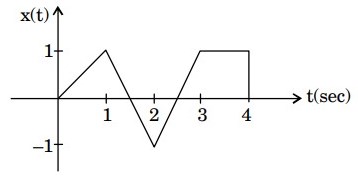51. Four independent messages have bandwidths of 100 Hz, 100 Hz, 200 Hz, and 400 Hz, respectively. Each is sampled at the Nyquist rate, and the samples are Time Division Multiplexed (TDM) and transmitted. The transmitted sample rate (in Hz) is
52. In a PCM system with uniform quantization, increasing the number of bits from 8 to 9 will reduce the quantization noise power by a factor of
53. The line code that has zero dc component for pulse transmission of random binary data is
54. In a baseband communications link, frequencies upto 3500 Hz are used for signaling. Using a raised cosine pulse with 75% excess bandwidth and for no inter-symbol interference, the maximum possible signaling rate in symbols per second is
55. An analog signal is band-limited to 4 kHz, sampled at the Nyquist rate and the samples are quantized into 4 levels. The quantized levels are assumed to be independent and equally probable. If we transmit two quantized samples per second, the information rate is
56. The minimum step-size required for a Delta-Modulator operating at 32 K samples/sec to track the signal (here u(t) is the unit-step function)
x(t) = 125t(u(t) - u(t - 1)) + (250 - 125t)(u(t - 1) - u(t - 2)) so that slope-overload is avoided, would be
x(t) = 125t(u(t) - u(t - 1)) + (250 - 125t)(u(t - 1) - u(t - 2)) so that slope-overload is avoided, would be
57. Consider the signal x(t) shown in the figure. Let h(t) denote the impulse response of the filter matched to x(t), with h(t) being non-zero only in the interval 0 to 4 sec. The slope of h(t) in the interval 3 < t < 4 sec is


58. Compression in PCM refers to relative compression of
59. If S represents the carrier synchronization at the receiver and p represents the bandwidth efficiency, then the correct statement for the coherent binary PSK is
60. In a digital communication system, transmissions of successive bits through a noisy channel are assumed to be independent events with error probability p. The probability of at most one error in the transmission of an 8-bit sequence is
Read More Section(Digital Communication)
Each Section contains maximum 100 MCQs question on Digital Communication. To get more questions visit other sections.
